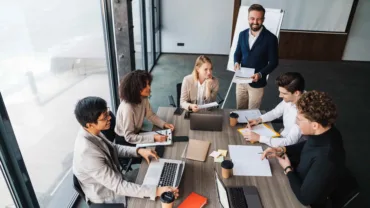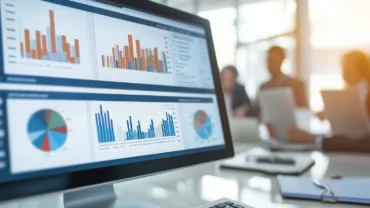As war in Ukraine and Gaza inflame human trafficking, organizations are stepping up the fight
Jump to:
| War can inflame human trafficking |
| What organizations can do |
| Conclusion |
In today’s world in which globalization has connected both economies and communities across borders, the scourge of human trafficking still remains a mostly hidden activity that can drive illicit profits in the shadows of global commerce even as it damages millions of lives.
Human trafficking, a form of modern slavery that includes forced labor and sexual exploitation, is not simply a human rights crime but also a financial crime that generates an estimated $150 billion per year, undermining economies and national security. Fortunately, more and more resources — in education, intervention by law enforcement, and technology-aided detection — are being leveraged against human trafficking. Now, a growing list of financial institutions, governments, and non-governmental organizations (NGOs) have stepped up the fight. Yet, to even start to combat this problem, financial institutions and other organizations need to be better trained, armed, and empowered to deny traffickers access to legitimate financial systems around the world.
Almost 28 million people are currently living under human trafficking conditions, and not surprisingly, women and children are being disproportionately affected, according to the International Labour Organization (ILO).
War can inflame human trafficking
Of those living under these terrible conditions, 6.3 million are in forced commercial sexual exploitation, with women and girls accounting for about 77% of those in such situations. Worse yet, regions in which active warfare is raging — such as Ukraine, Gaza, and elsewhere currently — become magnets for human traffickers, who descend on these areas and seek out people, again mostly women and children, who have been displaced and are more vulnerable to exploitation.
Given this, it is not surprising that in areas where there is ongoing war or climate catastrophe, human trafficking can become a bigger and far more dangerous problem. As the number of refugees around the world has dramatically increased — driven by many fleeing ongoing conflict, famine, or drought — the danger continues to grow.
Human traffickers are capitalizing on those fleeing war, particularly women and children refugees at their most vulnerable moments. And unfortunately, these traffickers often find a ready customer base in the West for trafficked people. For example, after Russia’s invasion of the Ukraine, demand for trafficked victims in the West spiked, according to data from TRSS, which identified a 200% to 600% increase in the use of internet search terms related to sex, pornography, and Ukrainian women in the days and weeks after the conflict started in February 2022.
Human trafficking expert, Val Richey, the Special Representative and Coordinator for Combating Trafficking in Human Beings at the Organization for Security and Cooperation in Europe, said in a recent Thomson Reuters podcast that human trafficking incidents often spike during high-profile events — such as large sporting events like the World Cup or the Super Bowl in the United States — and in regions of global conflict, in which unfortunately sex trafficking can become particularly widespread. In Ukraine, for example, the conditions for sex trafficking are elevated because the circumstances for exploitation for women are much more significant during the ongoing war than during times of peace, Richey explained, adding that more than five million people left their homes with little to no preparation in the early days of the war.
“I went to the borders of Ukraine in several different countries, and I saw Ukrainians crossing the border, often carrying nothing more than a bag or a duffel bag or a backpack,” he said. “Usually, it was women with a few children… but they had very little time to prepare… [and] they’re coming into this situation with a lot of vulnerability.”
In other war-torn regions, such as Gaza, Yemen, and the Sudan, there has been a significant spike in human trafficking activity, according to government sources. “Today, in Gaza, Ukraine, Yemen, and many other places in the world where there are ongoing conflicts, women are facing appalling violence and suffering,” according to Caritas International, a grassroots crisis-response organization. “Women and children make up around 80% of the world’s displaced people due to conflict, and are more likely to be victims of trafficking.”
What organizations can do
With such a weighty problem as human trafficking and its acceleration in war-torn regions, what can financial institutions, governments, and NGOs do to combat this scourge that exists not only on a global level, but within almost every community in the world. Human trafficking experts say that what is needed to combat these atrocities is increased collaboration among national and local governments, civil society, the private sector, and community members.
For example, during a recent Super Bowl held in Los Angeles, private agencies, including TRSS, partnered with law enforcement to disrupt human trafficking at the event. In addition, analysts and data scientists used technology and data to aid law enforcement in identifying and rescuing trafficking victims.
Indeed, increased use of technology to combat trafficking is showing some success. In Ukraine, for example, researchers used real-time, in-depth data analysis of internet patterns to examine whether there was a demand for Ukrainian women for sexual exploitation and trafficking. The analysis found clear signals that human traffickers are preying on Ukrainians escaping the war and that the demand for online sexual services is fueling the criminal profitability of exploitation.
The results led to a collaboration of government representatives, human trafficking experts, law enforcement agencies, and NGOs that were together able to extrapolate the findings to form a more detailed and complete picture of what was currently taking place in the region. Then, the group launched a global human trafficking awareness campaign to warn fleeing Ukrainians, especially women and girls, the risks they face from traffickers while sharing resources to help them stay safe.
In another example of using awareness campaigns to fight trafficking, Thomson Reuters recently took stewardship of the City of Houston’s world-class anti-trafficking toolkits and made them readily accessible online to cities and other public authorities. Through these step-by-step guides, municipal authorities can quickly mobilize anti-trafficking campaigns which may otherwise take years of planning, saving cities and towns money and other public resources.
Conclusion
Human trafficking remains a terrible stain on the world, and in many war-ravaged areas of the world, the exploitation of women and children become even worse. However, there is hope, according to anti-human trafficking experts. Collaboration among government representatives, human trafficking experts, law enforcement agencies, and NGOs around critical issues of communication and public education can greatly aid in the identification and dismantling of trafficking situations or networks.
Further, leveraging the use of advanced technology and information-sharing among agencies can jump-start efforts to disrupt trafficking and return victims to a life without fear and exploration.
You can access the new Thomson Reuters global Human Trafficking Resource Center, which houses the anti-human trafficking toolkits developed by the City of Houston.
Thomson Reuters is not a consumer reporting agency and none of its services or the data contained therein constitute a ‘consumer report’ as such term is defined in the Federal Fair Credit Reporting Act (FCRA), 15 U.S.C. sec. 1681 et seq. The data provided to you may not be used as a factor in consumer debt collection decisioning, establishing a consumer’s eligibility for credit, insurance, employment, government benefits, or housing, or for any other purpose authorized under the FCRA. By accessing one of our services, you agree not to use the service or data for any purpose authorized under the FCRA or in relation to taking an adverse action relating to a consumer application.








